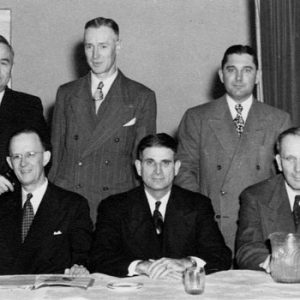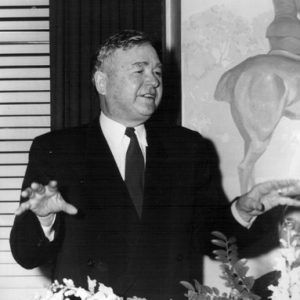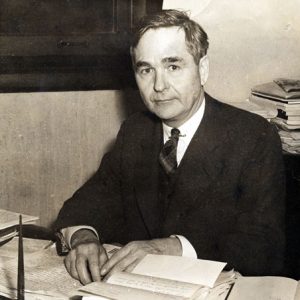calsfoundation@cals.org
Colter Hamilton (Ham) Moses (1888–1966)
Colter Hamilton (Ham) Moses served as secretary to governors George W. Donaghey, George W. Hays, and Charles Hillman Brough prior to becoming general counsel, president, and chairman of the board of Arkansas Power and Light (AP&L). Well known as an eloquent speaker, Moses represented the Governor’s Office in an entourage that traveled around the country promoting Arkansas; however, his greatest contribution to Arkansas resulted in the state moving from an agricultural economy to an industrial one during the post–World War II years. Although the state’s economy grew monumentally because of Moses’s efforts, he credited the people of Arkansas for the success of his “Arkansas Plan.”
C. Hamilton (Ham) Moses, the eldest of Angelus Gaston “A. G.” Moses and Mary Eulodia Dunn Moses’s three sons, was born on a farm in Hampton (Calhoun County) on June 28, 1888. His father was a farmer and lumberjack, and his mother taught first grade in Calhoun County schools. As a youth, Moses worked long hours performing farm chores and working in south Arkansas’s logging camps. After attending Hampton public schools, Moses graduated from Ouachita College (now Ouachita Baptist University) in 1908, where he specialized in debate and public speaking; from Tulane University in 1910 with a master’s degree in Southern history; and from the University of Arkansas Law Department in Little Rock (Pulaski County), now the University of Arkansas at Little Rock William H. Bowen School of Law, in 1911. He married Lena Goodwin of El Dorado (Union County) in September 1912, and they had three daughters and one son.
While Moses attended law school in Little Rock, he worked briefly in the Arkansas Department of Education prior to becoming Governor Donaghey’s secretary (1911–1913). When Donaghey left office, Moses relocated to Monticello (Drew County) and became the law partner of prosecuting attorney Bob Wilson. He maintained a law office in Monticello while serving as secretary to Governor Hays (1915–1917) and Governor Brough (1917–1919). Moses and T. Dwight Crawford coauthored Moses and Crawford Digest of Statutes in Arkansas, which was published in 1921. In 1919, Moses opened a law office in Little Rock and became general counsel to all of Harvey Couch’s business enterprises, including AP&L. In 1925, Moses joined U.S. Senator Joe T. Robinson and Joe House to form the law firm of Robinson, House, and Moses. After Couch’s death in 1941, Moses became president of AP&L.
During World War II, private power companies profited greatly as they operated at full capacity to meet war production demands; however, decreased power loads after the war created financial difficulties for utility companies, which eventually led to an intense struggle between public and private power entities in the 1940s. To increase public demand for electricity, Moses initiated his “Arkansas Plan,” designed to encourage community leaders to utilize local residents, resources, capital, and labor to strengthen their communities and attract business and industry into the state. The University of Arkansas (UA) in Fayetteville (Washington County), state organizations, and private corporations supported his efforts and organized to form the Arkansas Economic Council in December 1944.
Moses, Arkansas’s business cheerleader, visited many Arkansas communities and motivated Arkansans to demonstrate civic pride in their towns by making notable improvements to attract new industry. As a result, local residents enhanced their communities by paving city streets, whitewashing storefronts, landscaping public property, and developing recreational programs. They also built new houses, churches, hospitals, and schools, which attracted more industry to the state. Moses then traveled around the country preaching “the gospel of Arkansas” to draw corporate attention to the state. Within ten years, the state reaped bountiful harvests as new industry created 36,000 jobs with an annual payroll of $200 million, and Arkansas’s per capita income increased 225 percent; bank deposits rose 281 percent; and manufacturing volume soared 451 percent.
Moses retired as president of AP&L in 1952 but remained chairman of the board until 1955. He then joined Jimmy McClellan, Erwin Martin “E. M.” Arnold, Wayne Owen, and Harry McDermott Jr. to form the Little Rock law firm of Moses, McClellan, Arnold, Owen, and McDermott. Before his death, several business groups honored Moses for his efforts. He was named Arkansas’ Outstanding Citizen (1947), Arkansas Man of the Year (1948), and Man of the South (1950), and he received the Freedoms Foundation medal (1950). Harvey Couch honored Moses by naming Lake Hamilton for him. In December 1953, Reader’s Digest journalist William Hard aptly paid tribute to Moses by stating, “What a diplomat! What a businessman! What a promoter of social service! What a resister of socialization! What a fighter! What a Rebel!”
On July 25, 1966, Moses suffered a heart attack while dining at the Lafayette Hotel in Little Rock and died shortly afterward.
For additional information:
“Arkansas Traveler, 1953.” Time, February 9, 1953, pp. 88–89.
C. Hamilton Moses Papers, Special Collections. University of Arkansas Libraries, Fayetteville, Arkansas.
“Ham Moses: The Only Way Out is To Grow.” Business Week, May 30, 1953, pp. 72–84.
“‘Ham’ Moses Dies; Headed AP&L 15 Years.” Arkansas Gazette. July 26, 1966, pp. 1A–2A.
Williams, Fay. Arkansans of the Years. Little Rock: C. C. Allard and Associates, 1951.
Sherry Laymon
Hot Springs National Park, Arkansas

 Ben Laney with Congressional Delegation
Ben Laney with Congressional Delegation  Ham Moses
Ham Moses  Ham Moses
Ham Moses 



I remember reading an article in a Hot Springs magazine for tourists about Mr. Moses. It said that Mr. Moses and Mr. Couch rode horseback together in the hills near Hot Springs to observe where the lakes might spread in the valleys below.